Single-channel potentiostat/galvanostat with EIS Model CS350Pro consists of a DDS arbitrary function generator, a potentiostat/galvanostat and an FRA. With the help of built-in dual 24-bit Delta-sigma AD converters, it achieves excellent stability and high potential (1mV) and current(1pA) resolutions. With 40+ electrochemical techniques, CS350pro has been widely applied in corrosion, energy, material and analysis electrochemistry.
CS350Pro is an upgraded version of the conventional single-channel electrochemical workstation with outstanding stability and accuracy, advanced hardware, and fully functional software. EIS frequency can be as high as 5MHz.

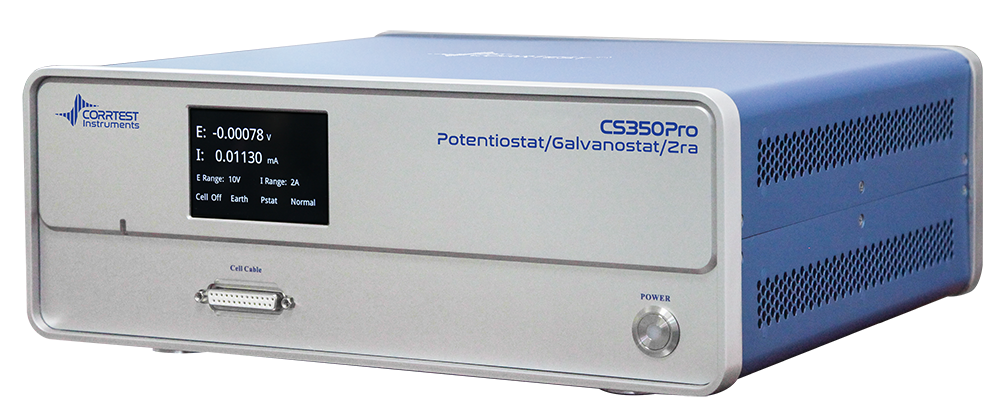
-1(1).png)
Application
●Study of Energy materials (Li-ion battery, solar cell, fuel cell, supercapacitors), advanced functional materials
● Bioelectrochemistry, sensors, electrosynthesis, electrodeposition (electroplating), anodic oxidation, electrolysis
● Electrocatalysis (HER, OER, ORR, CO2RR, NRR)
● Corrosion study and corrosion resistance evaluation of metals; quick evaluation of corrosion inhibitors, coatings, and cathodic protection efficiency
Corrosion Electrochemistry
CS potentiostats/galvanostats support a variety of electrochemical techniques for corrosion, such as OCP recorder, potentiodynamic, EIS, cyclic polarization (CPP), LPR, hydrogen diffusion test, zero resistance ammeter (ZRA), electrochemical noise (ECN), etc.
Due to their high input impedance(1013Ω), they are especially suitable for EIS measurement of high-impedance systems like coating, concrete, and pure water.
.png)

Polarization curve of Ti-based amorphous alloy & stainless steel in 3%NaCl solution
ECN of low-carbon steel in 0.05mol/LCl+0.1mol/LNaHCO3
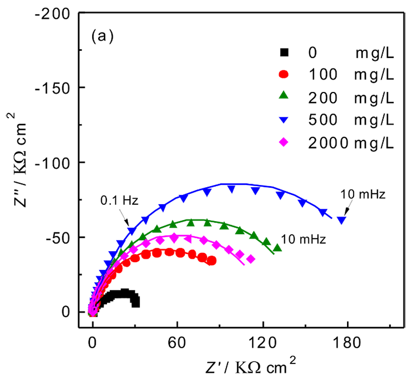
Salt spray aging test of high impedance coating
Energy & Battery testing
With versatile functions like linear sweep voltammetry (LSV), cyclic voltammetry (CV), galvanostatic charge/discharge (GCD),
EIS (including potentiostatic EIS and galvanostatic EIS)with precise IR compensation, CS potentiostats are widely used in supercapacitor, Li-ion batteries, Li-S batteries, fuel cell, solar cell, solid-state batteries, flow batteries, and metal-air batteries, etc.
.jpg)
CV curve of PPy supercapacitor in 0.5 mol/L H2SO4 solution
Electrocatalysis
Based on CV and LSV techniques, CS potentiostats can carry out long-term tests for ORR, OER, HER, and CO2 reduction, which is crucial for evaluating catalyst stability.
CS potentiostats can measure the half-wave potential (ORR) and overpotential (HER, OER) of catalysts and calculate the power density and energy density of Redox peaks.
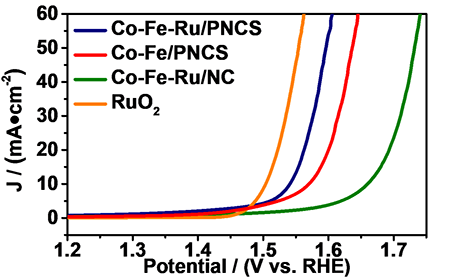
LSV curve of catalysts in alkaline solution
Analytical Electrochemistry
CS potentiostats include comprehensive voltammetric methods such as NPV, DPV, DNPV, SWV, and ACV, which make them ideal for quantitative analysis of trace elements via the intrinsic Voltammetry stripping techniques.
.png)
Stripping voltametric curves in solution of different Pb2+, Cd 2+,Zn2+ concentration
Technical Advantages
Switchable floating and earthing mode
All CS potentiostats/galvanostats can switch between the floating and earthing modes. This strategy is beneficial for studying electrochemical systems where the working electrodes are intrinsically ground, such as autoclaves, in-site concrete structures and multi-working electrodes requiring isolation, etc.
High-bandwidth EIS
With built-in digital FRA and arbitrary signal generator, as well as the high input impedance (1013W), the CS potentiostat is particularly suitable for EIS measurements of high-impedance systems (such as coating, membrane, concrete, etc.)
Based on the DC bias compensation technique, CS potentiostats can conduct EIS tests under charge/discharge state of batteries, making them suitable for ultra-low resistance systems, such as power batteries, fuel cells, water-splitting equipment, etc.
Multi electrode configurations
CS potentiostats support 2-, 3-, or 4-electrode configurations and can measure the galvanic current via built-in zero resistance ammeter circuits.
User-defined sequence test
CS Studio 6.0 for Windows software supports user-defined sequence tests ("combination test"), which can facilitate automatic testing according to user-defined experiment sequences.
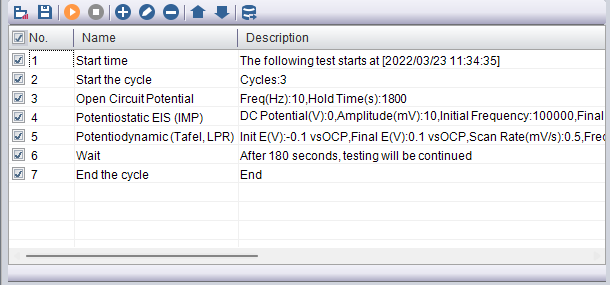
Sequence Test: corrosion tests

Sequence Test: Pseudocapacitor tests
Software development kit (SDK)
All CS potentiostats run under the control of CS Studio 6.0 for Windows (CSS 6.0). The CSS6.0 supports third-party languages, such as LabVIEW, C, C++, C#, VC, Python and others. Some API general interfaces and development examples can be supplied with the CS potentiostats. Through the SDK, customers can implement user-defined test methods.
Real-time data storage
CSS 6.0 saves experimental data timely, even if the experiment is accidentally interrupted by a power failure or computer shutdown. CSS 6.0 supports several data formats compatible with Originpro and Microsoft Excel.
Versatile data analysis
CSS 6.0 provides robust functions, including various electrochemical measurements and data analysis. It can complete Tafel plot fitting, CV derivation, integration and peak height analysis, EIS equivalent circuit fitting, etc.
3, 4 parameter polarization curve fitting.
EIS equivalent circuit fitting
Electrochemical noise spectrum analysis
Pseudo-capacitance calculation
GCD-specific capacitance, efficiency calculation
Mott-Schottky analysis
CV curve analysis
Activation/re-passivation curve analysis
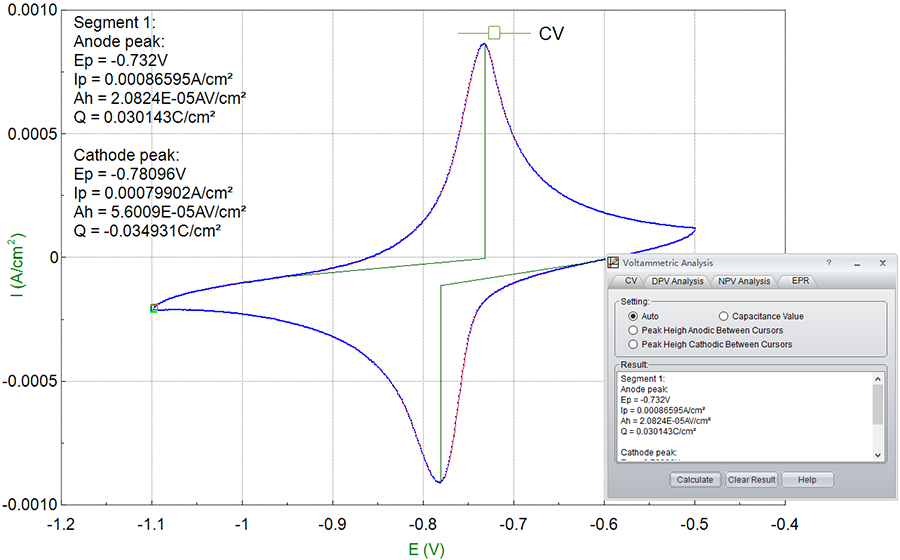
Software Features
Cyclic voltammetry:
CS studio software provides users a versatile smoothing/differential/ integration kit, which can complete the calculation of peak height, peak area and peak potential of CV curves. In CV technique, during the data analysis, there is function of selecting exact cycle(s) to show. You can choose to see a cycle or some cycles as you want. You can also export data or vector graph of an exact cycle or several cycles.
Tafel plot and corrosion rate:
CS studio also provides powerful non-linear fitting on Butler-Volmer equation of polarization curve. It can calculate Tafel slope, corrosion current density, limitation current, polarization resistance, corrosion rate. It can also calculate the power spectrum density, noise resistance and noise spectrum resistance based on the electrochemical noise measurements.

Battery Test and analysis:
charge & discharge efficiency, capacity, specific capacitance, charge & discharge energy.

EIS analysis: Bode, Nyquist, Mott-Schottky plot
During EIS data analysis, there is built-in fitting function to draw the custom equivalent circuit.
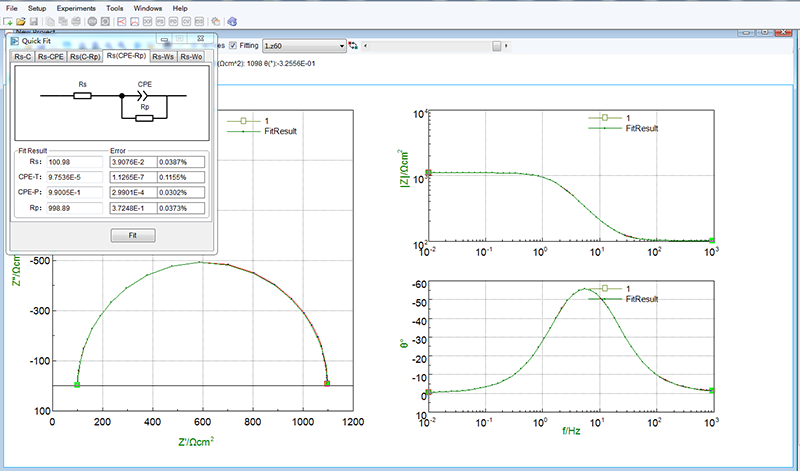







 Contact Us
Contact Us +86 13469965984
+86 13469965984